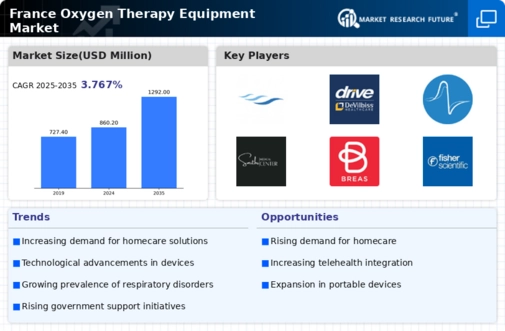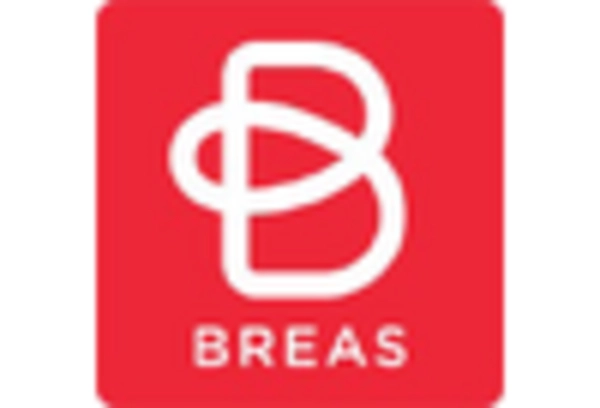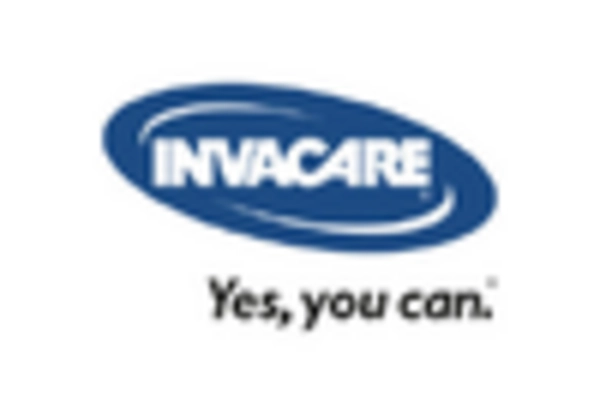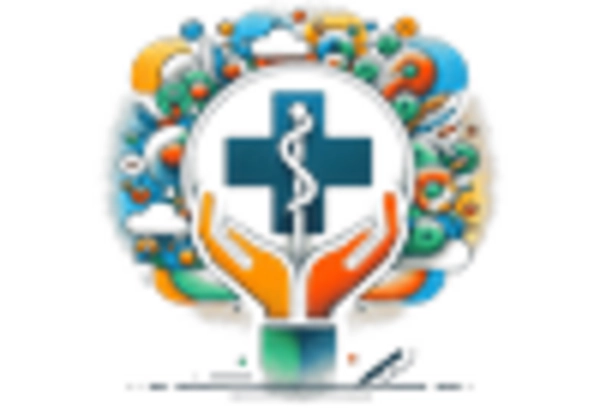Increased Awareness of Home Oxygen Therapy
There is a notable rise in awareness regarding the benefits of home oxygen therapy among patients and healthcare professionals in France. This awareness is fostering a shift towards outpatient care, where patients can manage their conditions from the comfort of their homes. The oxygen therapy-equipment market is experiencing a surge in demand as more patients are prescribed home oxygen therapy. Recent surveys indicate that nearly 60% of patients prefer receiving treatment at home rather than in clinical settings. This trend is further supported by advancements in portable oxygen devices, which enhance mobility and convenience for users. Consequently, the oxygen therapy-equipment market is likely to see increased sales and innovation in home-based solutions, catering to the growing preference for at-home healthcare.
Rising Prevalence of Respiratory Disorders
The increasing incidence of respiratory disorders in France is a primary driver for the oxygen therapy-equipment market. Conditions such as chronic obstructive pulmonary disease (COPD) and asthma are becoming more prevalent, affecting a significant portion of the population. According to recent health statistics, approximately 3.5 million individuals in France are diagnosed with COPD, which necessitates the use of oxygen therapy. This growing patient base is likely to propel demand for oxygen therapy equipment, as healthcare providers seek effective solutions to manage these chronic conditions. Furthermore, the aging population, which is more susceptible to respiratory ailments, is expected to contribute to the market's expansion. As a result, the oxygen therapy-equipment market is poised for growth, driven by the urgent need for effective treatment options for respiratory disorders.
Growing Demand for Aesthetic and Functional Design
The growing demand for aesthetically pleasing and functional designs in medical equipment is emerging as a notable driver for the oxygen therapy-equipment market. Patients increasingly seek devices that not only meet their medical needs but also align with their lifestyle preferences. Manufacturers are responding to this trend by developing oxygen therapy equipment that is both visually appealing and user-friendly. For instance, portable oxygen concentrators are now available in various colors and styles, making them more attractive to users. This shift towards design-oriented products is particularly relevant in France, where consumer preferences often emphasize aesthetics. As a result, the oxygen therapy-equipment market is likely to see an increase in product offerings that cater to this demand, potentially enhancing patient satisfaction and adherence to therapy.
Technological Innovations in Oxygen Delivery Systems
Technological advancements in oxygen delivery systems are significantly influencing the oxygen therapy-equipment market. Innovations such as portable oxygen concentrators and advanced nebulizers are enhancing the efficiency and effectiveness of oxygen therapy. These devices are designed to provide patients with greater flexibility and ease of use, which is particularly appealing to the aging population in France. Manufacturers are projected to invest in research and development to create more sophisticated and user-friendly equipment, driving market growth. For instance, the introduction of smart oxygen therapy devices that monitor patient usage and adjust oxygen flow accordingly is likely to improve treatment outcomes. As a result, the oxygen therapy-equipment market is expected to benefit from these technological innovations, leading to increased adoption and market penetration.
Supportive Government Policies and Reimbursement Schemes
Supportive government policies and reimbursement schemes are playing a crucial role in shaping the oxygen therapy-equipment market. The French government has implemented various initiatives aimed at improving access to healthcare services, including oxygen therapy. These policies often include reimbursement for oxygen therapy equipment, making it more affordable for patients. Recent data suggests that approximately 75% of the costs associated with oxygen therapy are covered by health insurance, which encourages more patients to seek treatment. Additionally, the government is actively promoting the use of home healthcare solutions, further driving the demand for oxygen therapy equipment. As these supportive measures continue, the oxygen therapy-equipment market is likely to experience sustained growth, benefiting both patients and manufacturers.

















Leave a Comment